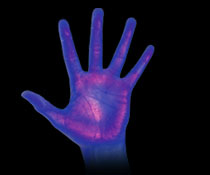Do You Know the Health Risks of Wet Hands?
Hand washing is recognized as a good way to prevent cold and flu. But hand drying is just as important – damp hands can spread up to 1,000 times more bacteria than dry ones.
According to an online survey conducted by Greenberg Quinlan Rosner Research for Dyson Ltd., over a third of Americans (39%) don’t always completely dry their hands after washing them and just 22% after coughing and sneezing.
It is stated that Americans spend more than $3.6 billion each year on cold remedies, but neglect a simple action that could help ward off cold and flu in the first place. It is washing and drying their hands.
[ Also Read: Public Service Ads to Protect You from Flu ]Impatience is said to be the main reason that people are not drying their hands, believes the hand dryer company Dyson.
It says people aren’t willing to wait more than 15 seconds to dry their hands, making fast hand drying critical to prevent the spread of cold and flu.
[ Also Read: Julie Bowen Joins the Influenza Campaign ]Traditional warm air dryers can take up to 43 seconds to thoroughly dry hands, and less than half of Americans are willing to wait that long. The Dyson Airblade hand dryer, a hands-in dryer, completely dries them in 12 seconds, claims the company.
[ Also Read: What Celebs Do to Keep You Healthy ]“Holiday cheer might not be the only thing you’re spreading if you don’t dry your hands completely after washing. The problem is two-fold, people don’t know they need to dry their hands and they aren’t willing to wait more than 15 seconds to do so,” says Danielle Stevenson, who helped develop the Dyson Airblade hand dryer as a Dyson microbiologist.
[ Also Read: Celebs Join Hands to Ensure Baby Health ]In addition to lack of time, more than 30% of people cite empty paper towel dispensers as the reason for not drying their hands. In high usage areas, stocks of clean paper towels can quickly run out making it more likely for people to leave the bathroom with damp hands.
Paper towels can also become contaminated and pose a hygiene hazard if not disposed of properly.
People are more likely to completely dry their hands if the method of drying works quickly (73%), completely dries their hands (78%) and reduces bacteria (80%) – but misperceptions about hand drying methods may be contributing to the spread of germs, and cold and flu.
Advertisements:
Business Proposal
Digital Media Campaigns
Raman Media Network: Connecting Communities
Nearly one-third believe that rubbing their hands together while drying helps get rid of any remaining bacteria. In reality, academic research has found that rubbing under a warm air dryer actually increases the bacteria on the surface of the skin, informs the company.
Most hand dryers, it says, do not filter the air used to dry the hands, recycling dirty washroom air instead.
As millions of people descend on airports, shopping centers and other public places in the coming weeks, the Centers for Disease Control and Prevention recommend taking simple, common sense steps to prevent cold and flu including:
- Wash your hands often and thoroughly using soap and warm water for at least 20 seconds – the amount of time it takes to sing “Happy Birthday” twice.
- Get a flu shot.
- Cover your mouth when you cough or sneeze.
- Stay home when you are sick.
For the survey, a national (U.S.) sample of 3,449 adults was drawn from online panels from Oct. 29 – Nov. 4, 2010. The results were announced today, Nov. 29.
Photo courtesy: Dyson






